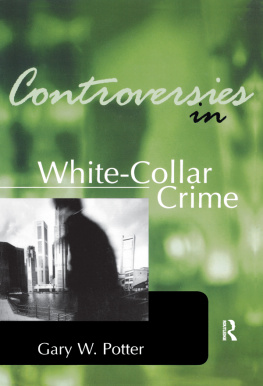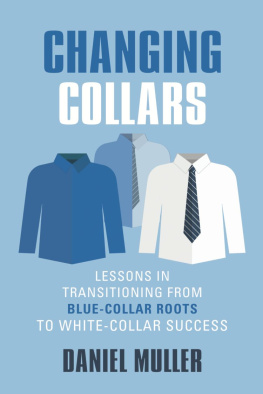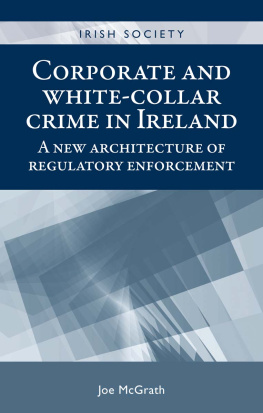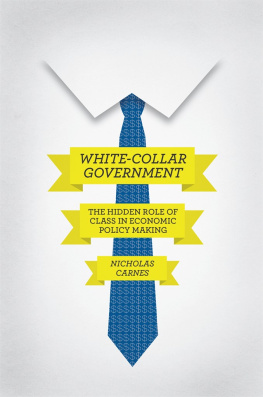Controversies in White-Collar Crime
First published 2002 by Anderson Publishing
Published 2015 by Routledge
2 Park Square, Milton Park, Abingdon, Oxon OX14 4RN
and by Routledge
711 Third Avenue, New York, NY 10017
Routledge is an imprint of the Taylor & Francis Group, an informa business
Copyright 2002 Taylor & Francis. All rights reserved.
No part of this book may be reprinted or reproduced or
utilised in any form or by any electronic, mechanical, or other means, now known or hereafter invented, including photocopying and recording, or in any information storage or retrieval system, without permission in writing from the publishers.
Notices
No responsibility is assumed by the publisher for any injury and/or damage to persons or property as a matter of products liability, negligence or otherwise, or from any use of operation of any methods, products, instructions or ideas contained in the material herein.
Practitioners and researchers must always rely on their own experience and knowledge in evaluating and using any information, methods, compounds, or experiments described herein. In using such information or methods they should be mindful of their own safety and the safety of others, including parties for whom they have a professional responsibility.
Product or corporate names may be trademarks or registered trademarks, and are used only for identification and explanation without intent to infringe.
Library of Congress Cataloging-in-Publication Data
Controversies in white-collar crime / edited by Gary W. Potter.
p. cm. -- (Controversies in crime and justice)
Includes bibliographical references and index.
ISBN 978-15-8360-514-1 (pbk)
1. Commercial crimes. 2. White collar crimes. 3. Globalization. I. Potter, Gary W. II. Series.
HV6768 .C66 2001
364. 168--dc21
00-048543
ISBN-13: 978-15-8360-514-1 (pbk)
| Cover design by Tin Box Studio, Inc. | EDITOR | Gail Eccleston |
| ASSISTANT EDITOR | Genevieve McGuire |
| ACQUISITIONS EDITOR | Michael C. Braswell |
Compiling an edited volume of original works from the best scholars in the field is a more prodigious task than it might at first seem. Simply deciding on the organization for the book and themes to be addressed while surveying the body of empirical work on white-collar crime was probably the hardest part. The task was made much easier and very pleasant by the excellent work done by the contributors for this volume, and the high degree of collegiality and cooperation they showed toward me. In that I was imposing on their already ambitious scholarly endeavors and their valuable time, I will be forever grateful for their generosity and enthusiasm.
In addition to the those who did the writing for this volume, many others helped out as well, including, I suspect, some who didnt even know they were helping. Vic Kappeler, who is the series editor, is someone I have worked with many, many times. He allowed me to proceed in my quirky way, and removed the obstacles that cropped up from time to time. He also, as always, overlooked my idiosyncracies and various personality disorders as the work progressed. We work well together and I hope we will continue to do so for the rest of my academic career. I also need to thank an unwitting accomplice in this task, Helen Eigenberg of the University of Tennessee at Chattanooga. Whether she knows it or not, Helen was largely responsible for how the theme of this work came together. A couple of years ago, sitting in the bar, at an ASC meeting in Washington, Helen lectured me (or as she might put it, engaged in a consensus-building discourse with me) on the fact that I had consistently failed to embed basic elements of feminist theory in my work. She was particularly irked by a chapter, of which I had been the primary author, in The Mythology of Crime and Criminal Justice. Ive never forgotten her admonitions, and have tried to do better in subsequent work. But, it was largely her suggestions that led me to try to highlight themes of gender, race, and class in the present volume. In addition to Vic and Helen, some other people also played a role in helping me put this book together through their advice and suggestions were Marjorie Zatz at Arizona State University, Laureen Snider at Queens College, Kitty Calavita at the University of California Irvine and Mickey Braswell at East Tennessee.
I also want to thank to thank my wife, Karen Miller, who worked with me on this project. In that our research interests often diverge and in that working with me on any writing project is often, politely put, trying, we usually go our own ways in scholarly endeavors. But this time I was able to persuade her to work with me on a chapter and to help me tidy up after my very untidy practices with regard to endnotes and references. She made the project much easier and more fun than it otherwise would have been. I hope we will work together again in the near future.
Finally, I need to thank everyone at Anderson Publishing who always makes getting a manuscript from paper to the the finished book easy.
Controversies in White-Collar Crime introduces the topic of white-collar crime in the tradition of Edwin Sutherland, as crime committed by a person of respectability and high status in the course of his occupation. The chapters written for this volume tackle all the major controversies related to white-collar crime: issues of definition, questions of harm and cost, conflicts of interest in enforcement and control, and questions of public policy. But the chapters written for this volume go far beyond the normal discourses of criminology, law and political science. They situate white-collar crime in a political-economic and social reality that captures its true scope and true threat. White-collar crime is not a pathology, not an aberration, not a dysfunction, but a normative exercise in doing business and making law in contemporary society. White-collar crime, in all its ramifications, from workplace crime, to graft and bribery, to corporate crime, and to political crimes by the state, is simply the way the we produce and sell products, the way we make law and adopt policy, the way we manage the lives of billions of people around the world.
The enormity of the issue is what this volume has tried to capture. At the turn of millennium, white-collar crime has gone global, impoverishing, subjugating, defrauding, maiming, killing, and disenfranchising those without respectability and high status in every corner of the world. It is ironic, but little discussed, that those most victimized by white-collar crime are also those most victimized by street crime and, not coincidentally, by those policies enacted by the state to control street crime. Women, who bear the brunt of violent victimization in a most personal and intimate way around the world, despite the pandering state and media portrayals of stranger violence and random violence, also bear the brunt of white-collar victimization. From corporate violence, to the political use of rape, to economic deprivation, to sexual harassment, it is women who are the special targets of those criminals of respectability and high status. Just as they are the primary victims of violent street crime, and just as they are the primary victims of the criminal justice system, racial, and ethnic minorities are selected for special carnage and degradation by white-collar criminals. From environmental racism, to the dumping of unsafe products, to the economic slavery perpetuated by international debts and the global reach of corporate enterprise, ethnic and racial minorities, from Nazi Germany of the 1930s to the African famines of the 1990s, face white-collar genocide. And finally, as Sutherland so clearly implied, it is those without respectability and high status, who die in the factories, who eat the poisoned food, who are subjected to the dangerous and fraudulently tested drugs, who die in the nursing homes and are turned away by the hospitals. Objectively white-collar crime is defined by class; objectively white-collar crime denies economic, political, social, and human dignity to the overwhelming majority of people in this world who work at dangerous and alienating jobs and who give their lives to make others rich, respectable, and of high status. The articles in this volume seek to embed race, class, and gender as fundamental to any explication of white-collar crime.








